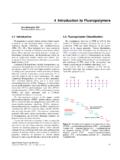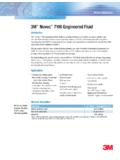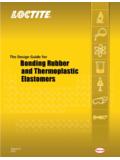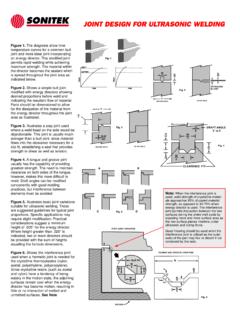Transcription of Products evolved during hot gas welding of …
1 Health and Safety Executive Products evolved during hot gas welding of fluoropolymers Prepared by the Health and Safety Laboratory for the Health and Safety Executive 2007 RR539 Research Report Health and Safety Executive Products evolved during hot gas welding of fluoropolymers Chris Keen BSc CertOH Mike Troughton BSc PhD CPhys MInstP Derrick Wake BSc, Ian Pengelly BSc, Emma Scobbie BSc Health and Safety Laboratory Broad Lane Sheffield S3 7HQ This report details the findings of a research project which was performed as a collaboration between the Health and Safety Executive (HSE) and The welding Institute (TWI). The project aim was to identify and measure the amounts of Products evolved during the hot gas welding of common fluoropolymers, to attempt to identify the causative agents of polymer fume fever.
2 Carbonyl fluoride and/or hydrogen fluoride were detected from certain fluoropolymers when these materials were heated to their maximum welding temperatures. Significant amounts of ultrafine particles were detected from all of the fluoropolymers investigated when they were hot gas welded. The report concludes that fluoropolymers should be hot gas welded at the lowest possible temperature to reduce the potential for causing polymer fume fever in operators. If temperature control is not sufficient to prevent episodes of polymer fume fever, a good standard of local exhaust ventilation (LEV) should also be employed. This report and the work it describes were funded by the Health and Safety Executive (HSE). Its contents, including any opinions and/or conclusions expressed, are those of the authors alone and do not necessarily reflect HSE policy.
3 HSE Books Crown copyright 2007 First published 2007 All rights reserved. No part of this publication may be reproduced, stored in a retrieval system, or transmitted in any form or by any means (electronic, mechanical, photocopying, recording or otherwise) without the prior written permission of the copyright owner. Applications for reproduction should be made in writing to: Licensing Division, Her Majesty s Stationery Office, St Clements House, 2 16 Colegate, Norwich NR3 1BQ or by e mail to hmsolicensing@cabinet ii CONTENTS 1 1 1 Materials studied .. 1 Overview of the current study .. 4 2 Experimental .. 5 Measurement of airborne material .. 5 Stage 1 heating trials .. 6 Stage 2 heating trials .. 7 welding trials.
4 7 Hot bar welding 8 3 Results .. 9 Validation of carbonyl fluoride measurement method .. 9 Temperature measurements during welding .. 10 Results of air sampling .. 11 4 Discussion .. 16 Possible control strategies .. 19 5 Conclusions and recommendations .. 21 iii iv EXECUTIVE SUMMARY This report details the findings of a research project which was performed as a collaboration between the Health and Safety Executive (HSE) and The welding Institute (TWI). The practical work was lead for HSE by the Health and Safety Laboratory (HSL). OBJECTIVES To identify and measure the amounts of Products evolved during the hot gas welding of the fluoropolymers PVDF, ECTFE, PFA and FEP and also during the heating of PTFE.
5 MAIN FINDINGS Very little in the way of general volatile organic compounds (VOCs) was detected from any of the fluoropolymers during heating trials. Neither carbonyl fluoride nor hydrogen fluoride were detected from PVDF or PTFE during heating trials to the recommended and maximum welding temperatures. Hydrogen fluoride was detected when ECTFE was heated to the recommended welding temperature in air. Carbonyl fluoride was detected when ECTFE was heated to its maximum welding temperature in air. The manufacturers of ECTFE recommend that it is hot gas welded under nitrogen. Neither hydrogen fluoride nor carbonyl fluoride were detected when ECTFE was heated under nitrogen. Carbonyl fluoride and/or hydrogen fluoride were detected from both PFA and FEP when these materials were heated to their maximum welding temperatures.
6 Significant amounts of ultrafine particles were detected from all of the fluoropolymers investigated when they were hot gas welded. Other researchers have suggested that polymer fume fever is caused by a combination of ultrafine particulate and toxic chemical agents (predominantly carbonyl fluoride and/or hydrogen fluoride). The fact that these materials were detected during this work lends further weight to this theory. The use of hot bar welding for joining PTFE to PFA, PTFE to FEP and ECTFE to ECTFE, was briefly investigated. No carbonyl fluoride or hydrogen fluoride was detected from this activity. v RECOMMENDATIONS Air monitoring for carbonyl fluoride and/or hydrogen fluoride may be useful when investigating cases of polymer fume fever.
7 However, it should be remembered that, where ultrafine particles are also present, these chemical agents may exhibit toxic effects at much lower levels than where they are present alone. Urinary fluoride monitoring may be useful when investigating polymer fume fever. However, this would require further investigation. Fluoropolymers should be hot gas welded at the lowest possible temperature to reduce the potential for causing polymer fume fever in operators. If temperature control is not sufficient to prevent episodes of polymer fume fever, a good standard of local exhaust ventilation (LEV) should be employed. LEV systems should be designed to enclose the welding process as much as possible.
8 If portable, flexible arm type LEV systems are used, the operators should receive adequate training to allow them to be used effectively. It is possible that on-tool extraction systems may be applicable in this setting. Correctly used, P3 rated respiratory protective equipment can offer good protection against the ultrafine particulate material which is implicated in the cause of polymer fume fever. As always, however, RPE should only be employed when engineering controls alone do not offer adequate protection. Any industrial process which involves gross overheating of fluoropolymers, such as laser cutting, should be the subject of a rigorous risk assessment. vi 1 INTRODUCTION BACKGROUND Fluoropolymers are a group of plastic type materials possessing a high degree of resistance to chemical attack.
9 They are used to fabricate structures for use in the chemical, semi-conductor, paper and pharmaceutical industries. They are also used in buildings and tents where a high degree of weather resistance is required of a plastic material. Heating these materials to excessive temperatures can cause a degree of thermal degradation, and the airborne material generated in this way can be harmful to human health (Auclair et al 1983, Clarke et al 1990, Purser 1992, Schusterman 1993). The most common hot processing method used with these materials is hot gas welding , and episodes of ill health, referred to as polymer fume fever, are not uncommon amongst workers performing this technique.
10 Polymer fume fever is an acute, influenza type illness. Symptoms manifest themselves within a few hours of exposure to the fume from heated fluoropolymers, and usually subside, without treatment, within 24 to 48 hours provided no further exposure occurs. However, in extreme cases, fatal poisonings have occurred (Auclair et al 1983). Currently there is no information to suggest that there is any chronic illness associated with exposure to fume from heated fluoropolymers. Although polymer fume fever is a well known illness in the fluoropolymers industry, there is debate about which components of the fume actually cause the symptoms. Some researchers have implicated gaseous and vapour phase material (Coleman et al 1968).















